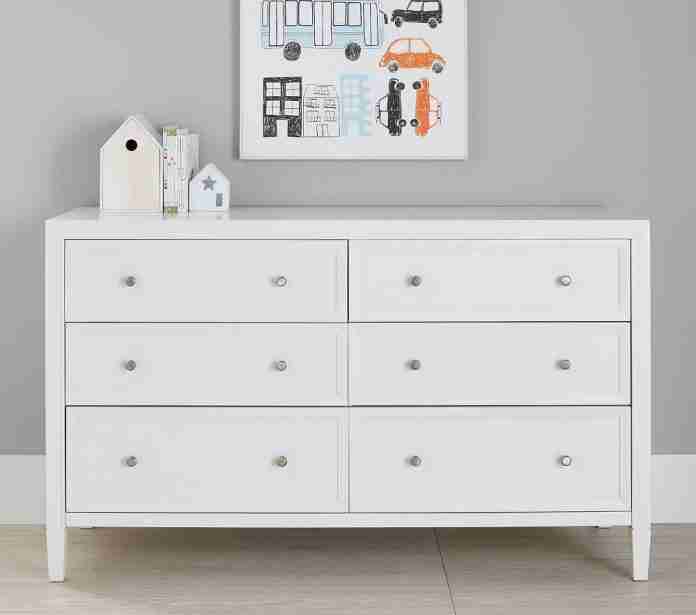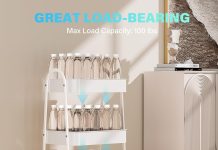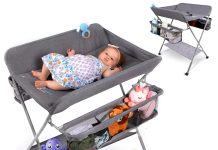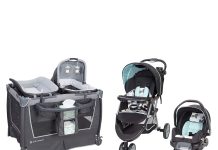Nursery dressers should be seen as an essential part of nursery furniture and right after the nursery in terms of importance.
Not only is it one of the most critical storage items you can buy for your baby’s needs, but modern nursery dressers are stunning and incredibly elegant.
At the same time, some are also designed to fill a certain number of features and store diapers and small baby clothes.
When it comes to choosing nursery furniture, it can be hard to know where to start. There are so many choices and it can feel like a daunting task. Don’t worry—here are some tips for choosing nursery furniture that will make the process easier.
First, think about what kind of nursery you’re planning to create. Will it be a boy’s room or a girl’s room? If you have children of both sexes, you may want to consider mixed-gender furniture.
Second, think about your child’s age and size. Nursery furniture is often designed for babies and toddlers, but as your child gets older, they may outgrow their crib or bed. In this case, consider buying a toddler bed or convertible crib instead of expensive full-sized furniture.
Finally, consider what your nursery will be used for. Will you be using it just for daytime naps and short visits? Or will you need more space for overnight stays? This is something you’ll need to factor in when selecting nursery furniture.
By following these tips, you’ll be able to choose nursery furniture that best suits your needs and preferences.
Review contents
How To Choose a Dresser for Your Baby’s Nursery
If you need to save space, this can be crucial, and if you love the convenience of multifunctional furniture, this is also an ideal choice.
Dresser size options
The dressers can include an unlimited number of drawers and storage spaces, from two small single drawers to ten or more, and depending on your size, budget, and style requirements, you must choose the one that best suits you and your baby.
Fortunately, nurseries no longer look like they were designed centuries ago, and the nursery has become as elegant and modern as any other room in the house – that said, if you prefer the classic design, you can choose a traditional nursery from dressers designed to look aged but that offer the benefits of buying new ones.
Contemporary designs
Contemporary wardrobes are ideal for storage and offer a unique and unusual design.
The exact designs these offers vary depending on the model you choose, but, for example, the contemporary block design unit with six drawers has three rows of two drawers of different sizes.
Half of the drawers have a wooden finish, you can choose the color of one of the other drawers, and the last 2 have a dark wooden finish.
The overall effect is fun and modern, ideal for the contemporary nursery and a unit your child can grow.
Nursery Dressers Become Toddler Dressers
Nursery workers will often find themselves staying longer than expected. Kids can take a good, good-quality bedroom dresser to their first bedroom, so choosing a design that isn’t baby or toddler-oriented is a good idea.
Purchasing a new dresser every time you redecorate or change rooms is an additional expense you could certainly do without.
Consider the Size of the Nursery
When choosing nursery furniture, it’s important to take into account the size of the room and the age of your child. The dresser should be big enough to hold enough clothes, diapers, wipes and other necessities, but not so big that it takes up too much space. Some parents choose a single-tier dresser for younger babies, while others opt for a two- or three-tier dresser as their child grows. As with any furniture choice, it’s best to get help from a parent or grandparent when selecting a nursery set.
Consider the Style of the Nursery
When choosing a nursery dresser, it is important to consider the style of the room. A modern or contemporary dresser can go great with a modern nursery, while a more traditional dresser might be better for a traditional nursery. Once you have decided on the style, you can begin to look for specific features that will fit your needs. Some important considerations include whether the dresser has multiple storage areas and if there are any built-in changing stations.
Consider the Materials Used in the Nursery
When shopping for nursery dressers, it is important to consider the materials used in the dressers. Some of the most common materials used in nursery dressers are wood, metal, and plastic. Each of these materials has its own advantages and disadvantages.
Wooden nursery dressers are typically cheaper than metal or plastic nursery dressers, but they may not last as long. Wooden dressers may also require regular maintenance, such as refinishing or staining, to keep them looking fresh.
Metal and plastic nursery dressers are both relatively expensive, but they tend to last longer than wooden dressers. Metal and plastic dressers are also less likely to require regular maintenance, such as refinishing or staining. However, metal and plastic dressers can be more difficult to move around because they are heavier than woodendressers.
Ultimately, it is important to choose a nursery Dresser that is best suited for your needs and your budget.
Consider the Availability of the Nursery
When looking for a nursery dresser, consider the availability of the piece. Some nurseries may only have smaller dressers available, while others may have larger ones. It is important to find a dresser that will fit into the space and will accommodate all of your child’s needs. Additionally, be sure to factor in how much storage the dresser has. Some nurseries offer more drawer space than others.
Consider Your Budget
When looking for a nursery dresser, it is important to consider your budget. There are a variety of different types and styles of dressers available at various price points, so it is important to find one that fits your needs and your aesthetic preferences.
Some tips for choosing a nursery dresser based on your budget include:
-Start by considering what you need the dresser for. Is it primarily for storage space, or does it need to be stylish and contemporary?
-Next, think about how much you want to spend. Do you want a cheaper option that may not meet all of your needs, or do you want something more expensive but guaranteed to be good quality?
-Consider what style of dressing room you have. If you have an older child’s bedroom with minimal storage space, a modern dresser may not be the best option. Conversely, if you have a more spacious room and are looking for something that will look good for years to come, a traditional dresser might be better suited.
-Finally, take into account your own personal preferences. Do you like dark wood or light wood? Are traditional drawers or open shelves more your style? Once you have figured out what you need and what style is best for your room, shopping can begin!
What should I look for in a nursery dresser?
When looking for a nursery dresser, consider the layout of your room and what you will be storing in it. This will help you select the right type of dresser for your needs.
Some nurseries require a high-boy or high-boy style dresser to fit extra large items such as bassinets and changing tables. If this is the case in your nursery, be sure to choose a dresser that offers plenty of storage space. Some other features to look for when selecting a nursery dresser are drawers that open all the way, adjustable height rails, and cubbies or shelves for storage.
How can you tell a quality dresser?
When shopping for a nursery dresser, it is important to keep in mind the following tips:
-Consider the intended use of the dresser. A dresser that will be used for storing clothes may not be the best choice for a nursery that will primarily function as a play area.
-Think about how much storage space you need. A midsized dresser may be adequate for one child, but could become too crowded if there are several children in the nursery at once. Conversely, a large dresser may not be necessary if your child will only have clothing and no other toys or items stored in the dresser.
-Be aware of whether the dresser features drawers or shelves. Many nurseries now come with built-in changing tables and storage cabinets, meaning that drawers are no longer necessary on many bedroom furniture pieces. If you are considering purchasing a piece of bedroom furniture with drawers, make sure to ask the store how many they have available and what sizes they are in order to accommodate your specific needs.
-Check out reviews online before making your purchase. Online reviews can provide valuable insight into how other parents have used a particular piece of furniture and what problems they encountered while using it.
What are the dos and don’ts of decorating nurseries?
Decorating a nursery can be a daunting task, but with a little bit of research and preparation it can be fun and stylish. Here are some tips for choosing nursery dressers:
1. Think about the style of your home. In contemporary homes, often there is not a lot of furniture that is in the traditional baby-themed colors, like pink and blue. So if you’re looking for a dresser that will work well with any style of home, go with something neutral or modern looking.
2. Consider the space you have. If you have limited storage space, don’t buy a large dresser – instead think about what functions you need the dresser to fulfill (i.e., storage for clothes, toys, diapers, etc.) and go with something smaller that does those things well.
3. Pay attention to how the pieces are constructed. A good rule of thumb is to avoid super heavy pieces that will take up a lot of room on the wall and instead opt for something that has more slender lines so it looks less bulky. And make sure all hardware is included – many nurseries require screws or bolts to hold everything in place so make sure to bring those along when shopping!
4. Finally, choose something that you’ll love and won’t get tired of seeing every day!
What is the best color for a nursery?
There are many different colors to choose from when designing a nursery, and it can be a little overwhelming. Some parents prefer bold, bright colors while others prefer more subtle shades. Ultimately, the best color for a nursery depends on your personal preferences and the style of the room. Here are some tips to help you choose the right color for your nursery:
-Start by sketching out a rough idea of what you want your nursery to look like. This will help you narrow down your options and make sure you are choosing a color that matches your vision.
-Once you have an idea of what you want, begin looking at different color palettes online or in magazines. Try to find several different shades that fit your style and see which one is your favorite.
-When you have decided on a color, start looking for furniture that is compatible with it. This includes walls, flooring, cribs and other accessories. You may need to switch up some of the decorating items in order to match the new color scheme.
What two things are important to consider when choosing a baby’s clothing?
When selecting clothing for a baby, there are a few things to keep in mind. First, it is important to consider the baby’s size and shape. Second, it is important to choose clothing that will be comfortable and provide adequate coverage. Third, it is important to choose clothing that will be easy to care for and look good when the baby grows into it. Here are some tips for choosing baby clothes:
1. Consider the baby’s size and shape. A newborn typically wears small sizes, while an older baby or toddler might need larger sizes. Also, take into account how much growth the baby will undergo during their first year of life.
2. Choose clothing that is comfortable and provides adequate coverage. Some babies might prefer more coverage than others; this can be determined by what kind of weather the baby is likely to encounter (e.g., cold weather requires more layers of clothing). When shopping for clothing, make sure that each piece covers at least part of the body so that no skin is exposed.
3. Choose clothing that will be easy to care for and look good when the baby grows into it. Clothing should fit well so that it doesn’t become too tight or loose over time, as this can lead to discomfort or even safety risks (e.g., exposing soft spots on a child’s skin). Additionally, make sure all of the clothes in a child’s wardrobe are appropriate for the season (e.g., summer suits should not be worn in winter).
Do you need a special dresser for nursery?
If you’re having trouble choosing a nursery dresser, here are some tips to help you out. First, decide what type of dresser you need. You can go with a traditional dresser that has several drawers or shelves, or a more unique style that is more like a small sideboard. Once you have decided on the type of dresser you need, consider the layout of your nursery. Do you want a separate drawer for each item in baby’s wardrobe, or do you want one big drawer where everything is housed? Also, think about how much storage space you’ll need and whether or not the dresser will fit in your nursery’s space. If you’re Unsure Whether A Dresser Is Right For You, Consider Seeking Advice From A Friend Or Family Member Who Has Kids Already. They Can Give You Some Good Ideas About Style And Storage Space That Will Work Well In Your Nursery.”
Adding additional functionality
Modal units can see their functionality increased thanks to a variety of add-ons.
You can even transform the unit into a practical changing table, eliminating the need to keep bending over to change your baby.
This makes nursery dressers even more helpful, and when your child grows and outgrows a changing table, the add-on can be removed again, leaving a more mature dresser.
The complete nursery
Nursery dressers are essential items for any nursery.
They can combine many different functions with various add-ons and classic designs. You can also use contemporary-looking baby furniture with tremendous and modern nursery dressers.
Remember that a nursery can become a toddler bedroom chest, and choose a quality one that looks good and will last for years.



































